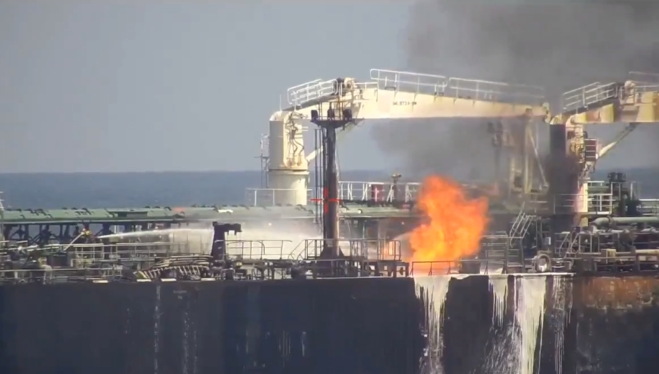
A picture posted by the Indian Navy on social media X shows that the Visakhapatnam-class destroyer deploys a team to assist in putting out the fire caught on UK's tanker Marlin Luanda on January 27. Source: X account of Indian Navy
Since December 2023, the Indian Navy has been the "first responder" to several incidents of merchant ship attacks in the Middle East region, according to Indian media reports on January 27. An article by the Wall Street Journal also noted the recent performance of the Indian Navy and said that the "Red Sea conflict prompts India's navy to flex its muscles." Military experts explained that India's proactive role in the Red Sea conflict aims to achieve three goals.
The UK's tanker Marlin Luanda was hit by a missile from Yemen's Houthi armed forces in the Gulf of Aden on January 26. Upon receiving a distress signal, the Indian Navy dispatched the missile destroyer Visakhapatnam to assist in firefighting. The Indian media outlet India Sentinels reported that this is not the first time that Visakhapatnam has responded to incidents of merchant ships being attacked in the region. Earlier this month (January 17), the Indian Navy destroyer also responded to a drone attack on the UScargo ship Genco Picardy in the Gulf of Aden.
The report stated that the Indian Navy has been the "first responder" to several incidents of merchant ship attacks in the region since December 2023. Due to the increasing attacks on merchant ships and piracy attempts in the region, the Indian Navy has strengthened surveillance and patrols in the northern and central Arabian Sea and deployed top-notch warships, drones, and aircraft. According to the website of Hindustan Times at the end of December 2023, the Indian Navy had deployed five missile destroyers, a replenishment ship, a P-8I anti-submarine patrol aircraft, and a Sea Guardian drone to ensure the security of shipping routes from the Bab el-Mandeb Strait to the Indian coast. The Wall Street Journal's report on January 25 with the title Red Sea Conflict Prompts India's Navy to Flex Its Muscles stated that India has deployed 10 warships to the region extending from the northern and central Arabian Sea to the Gulf of Aden, while typically only two warships are deployed in the area. These warships monitor vessels flying the Indian flag but have also become emergency responders to recent incidents.
Military expert Zhang Junshe said in an interview with the Global Times on January 28 that India's proactive role in the Red Sea conflict aims to achieve three goals. First, as the situation in the Red Sea continues to escalate, the maritime risks in the Indian Ocean are increasing and thus India has dispatched warships to protect merchant ships to maintain maritime security. Second, India has always touted itself as a major power. Thus dispatch of advanced anti-aircraft missile destroyers is a demonstration of its power, aiming to deterring coastal countries in the Indian Ocean and showcasing its military strength. Third, India's move is also a gesture to show goodwill towards the US. Although India did not participate in the US-led Red Sea escort alliance, it significantly increased its escort forces in the region, and many believe that India's move is responding to US demands.
Zhang believes that the facts have proved that US-led Red Sea escort alliance did not resolve the Red Sea conflict. In this context, Indian's sending warships to patrol the area will not work in calming the Red Sea conflict either. China has consistently advocated for maintaining the security of international waterways, opposing attacks on civilian ships, and actively working towards comprehensive solutions through dialogue, negotiation, and political means to address regional hotspot issues. The tense situation in the Red Sea is a prominent manifestation of the spillover of the Gaza conflict. The immediate priority is to quickly quell the flames of the Gaza conflict and prevent the conflict from further expanding or even spiraling out of control. It is hoped that all relevant parties can play a constructive and responsible role in maintaining the safety and stability of the Red Sea region.
Editor's note: Originally published on huanqiu.com, this article is translated from Chinese into English and edited by the China Military Online. The information and opinions in this article do not necessarily reflect the views of eng.chinamil.com.cn.













